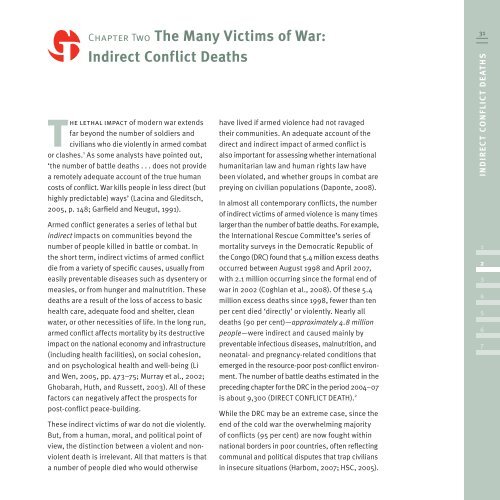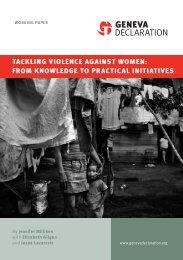Global Burden of Armed Violence - The Geneva Declaration on ...
Global Burden of Armed Violence - The Geneva Declaration on ...
Global Burden of Armed Violence - The Geneva Declaration on ...
Create successful ePaper yourself
Turn your PDF publications into a flip-book with our unique Google optimized e-Paper software.
Chapter Two <str<strong>on</strong>g>The</str<strong>on</strong>g> Many Victims <str<strong>on</strong>g>of</str<strong>on</strong>g> War:<br />
Indirect C<strong>on</strong>flict Deaths<br />
<str<strong>on</strong>g>The</str<strong>on</strong>g> lethal impact <str<strong>on</strong>g>of</str<strong>on</strong>g> modern war extends<br />
far bey<strong>on</strong>d the number <str<strong>on</strong>g>of</str<strong>on</strong>g> soldiers and<br />
civilians who die violently in armed combat<br />
or clashes. 1 As some analysts have pointed out,<br />
‘the number <str<strong>on</strong>g>of</str<strong>on</strong>g> battle deaths . . . does not provide<br />
a remotely adequate account <str<strong>on</strong>g>of</str<strong>on</strong>g> the true human<br />
costs <str<strong>on</strong>g>of</str<strong>on</strong>g> c<strong>on</strong>flict. War kills people in less direct (but<br />
highly predictable) ways’ (Lacina and Gleditsch,<br />
2005, p. 148; Garfield and Neugut, 1991).<br />
<str<strong>on</strong>g>Armed</str<strong>on</strong>g> c<strong>on</strong>flict generates a series <str<strong>on</strong>g>of</str<strong>on</strong>g> lethal but<br />
indirect impacts <strong>on</strong> communities bey<strong>on</strong>d the<br />
number <str<strong>on</strong>g>of</str<strong>on</strong>g> people killed in battle or combat. In<br />
the short term, indirect victims <str<strong>on</strong>g>of</str<strong>on</strong>g> armed c<strong>on</strong>flict<br />
die from a variety <str<strong>on</strong>g>of</str<strong>on</strong>g> specific causes, usually from<br />
easily preventable diseases such as dysentery or<br />
measles, or from hunger and malnutriti<strong>on</strong>. <str<strong>on</strong>g>The</str<strong>on</strong>g>se<br />
deaths are a result <str<strong>on</strong>g>of</str<strong>on</strong>g> the loss <str<strong>on</strong>g>of</str<strong>on</strong>g> access to basic<br />
health care, adequate food and shelter, clean<br />
water, or other necessities <str<strong>on</strong>g>of</str<strong>on</strong>g> life. In the l<strong>on</strong>g run,<br />
armed c<strong>on</strong>flict affects mortality by its destructive<br />
impact <strong>on</strong> the nati<strong>on</strong>al ec<strong>on</strong>omy and infrastructure<br />
(including health facilities), <strong>on</strong> social cohesi<strong>on</strong>,<br />
and <strong>on</strong> psychological health and well-being (Li<br />
and Wen, 2005, pp. 473–75; Murray et al., 2002;<br />
Ghobarah, Huth, and Russett, 2003). All <str<strong>on</strong>g>of</str<strong>on</strong>g> these<br />
factors can negatively affect the prospects for<br />
post-c<strong>on</strong>flict peace-building.<br />
<str<strong>on</strong>g>The</str<strong>on</strong>g>se indirect victims <str<strong>on</strong>g>of</str<strong>on</strong>g> war do not die violently.<br />
But, from a human, moral, and political point <str<strong>on</strong>g>of</str<strong>on</strong>g><br />
view, the distincti<strong>on</strong> between a violent and n<strong>on</strong>violent<br />
death is irrelevant. All that matters is that<br />
a number <str<strong>on</strong>g>of</str<strong>on</strong>g> people died who would otherwise<br />
have lived if armed violence had not ravaged<br />
their communities. An adequate account <str<strong>on</strong>g>of</str<strong>on</strong>g> the<br />
direct and indirect impact <str<strong>on</strong>g>of</str<strong>on</strong>g> armed c<strong>on</strong>flict is<br />
also important for assessing whether internati<strong>on</strong>al<br />
humanitarian law and human rights law have<br />
been violated, and whether groups in combat are<br />
preying <strong>on</strong> civilian populati<strong>on</strong>s (Dap<strong>on</strong>te, 2008).<br />
In almost all c<strong>on</strong>temporary c<strong>on</strong>flicts, the number<br />
<str<strong>on</strong>g>of</str<strong>on</strong>g> indirect victims <str<strong>on</strong>g>of</str<strong>on</strong>g> armed violence is many times<br />
larger than the number <str<strong>on</strong>g>of</str<strong>on</strong>g> battle deaths. For example,<br />
the Internati<strong>on</strong>al Rescue Committee’s series <str<strong>on</strong>g>of</str<strong>on</strong>g><br />
mortality surveys in the Democratic Republic <str<strong>on</strong>g>of</str<strong>on</strong>g><br />
the C<strong>on</strong>go (DRC) found that 5.4 milli<strong>on</strong> excess deaths<br />
occurred between August 1998 and April 2007,<br />
with 2.1 milli<strong>on</strong> occurring since the formal end <str<strong>on</strong>g>of</str<strong>on</strong>g><br />
war in 2002 (Coghlan et al., 2008). Of these 5.4<br />
milli<strong>on</strong> excess deaths since 1998, fewer than ten<br />
per cent died ‘directly’ or violently. Nearly all<br />
deaths (90 per cent)—approximately 4.8 milli<strong>on</strong><br />
people—were indirect and caused mainly by<br />
preventable infectious diseases, malnutriti<strong>on</strong>, and<br />
ne<strong>on</strong>atal- and pregnancy-related c<strong>on</strong>diti<strong>on</strong>s that<br />
emerged in the resource-poor post-c<strong>on</strong>flict envir<strong>on</strong>ment.<br />
<str<strong>on</strong>g>The</str<strong>on</strong>g> number <str<strong>on</strong>g>of</str<strong>on</strong>g> battle deaths estimated in the<br />
preceding chapter for the DRC in the period 2004–07<br />
is about 9,300 (DIRECT CONFLICT DEATH). 2<br />
While the DRC may be an extreme case, since the<br />
end <str<strong>on</strong>g>of</str<strong>on</strong>g> the cold war the overwhelming majority<br />
<str<strong>on</strong>g>of</str<strong>on</strong>g> c<strong>on</strong>flicts (95 per cent) are now fought within<br />
nati<strong>on</strong>al borders in poor countries, <str<strong>on</strong>g>of</str<strong>on</strong>g>ten reflecting<br />
communal and political disputes that trap civilians<br />
in insecure situati<strong>on</strong>s (Harbom, 2007; HSC, 2005).<br />
31<br />
I N D I R EC T CO N F L I C T DE AT H S<br />
1<br />
2<br />
3<br />
4<br />
5<br />
6<br />
7









